Non-Traditional Paths to Product by Sisu CPO

Berit Hoffmann came into Product Management very early on in her career and fell in love. Hear how she worked at various early stage companies, eventually became Google Head of Product, and then found her way back to the startup world as Sisu Chief Product Officer.
Berit talks about the unexpected ways in which working at Google changed her product strategy, how she hires for startups, and why she is passionate about helping companies use data to make better business decisions.

I was taking a look at your LinkedIn profile and you are probably the first person I’ve ever met in my life that has the word product in every single job. Like, you are a pure-bred Product Person.
That’s true. Yes. I have been in Product roles pretty much my whole career and actually was very fortunate to have happened into that career and just have loved it. It’s been a fun ride.
Tell me a little bit more about that first job. How did you become a Product Manager from the get-go?
Yeah, absolutely. I will say, even though I’ve been in Product roles my whole career, I had a pretty non-traditional path into Product. I think particularly in the Valley, we think of the archetype of a Product Person as someone who probably has a CS degree, has some training as an engineer. That was not me.
In undergrad, I studied history and economics and was very much liberal arts background. I was born and raised in Minnesota, and so the first company I joined was actually a Minnesota-based company. I moved back there after undergrad and joined a company, it was called Compellant. It was in the technology space, a data infrastructure/enterprise storage company. I had interned there in a marketing role, and was very fortunate that one of the leaders in the marketing department said to me, “Hey, you should do Product.”
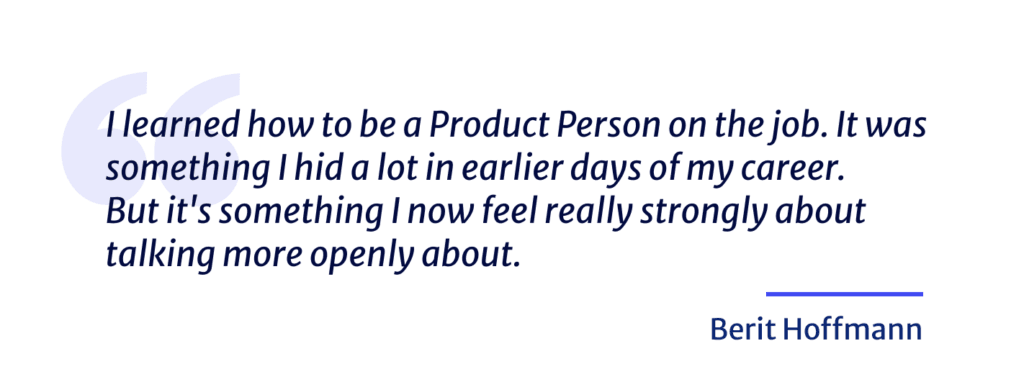
And I honestly didn’t even know what that meant, or what Product Management was. But I loved the company, I loved the pace it was growing, I loved being in the technology space. And so I said, “Okay, why don’t we give it a try?”
And candidly, my first boss probably did not want to hire me. I was not the background that he was used to hiring. So I say I all of that to say, I was very fortunate that a company was willing to place a bet on me. I learned a lot of both the technology and how to be a Product Person on the job. And that’s something I initially actually I think was reticent to talk about. It was something I hid a lot in earlier days of my career. I wanted to come across as, “I’m your typical technical background,” and almost hid that part of my path into Product.
But it’s something I now feel really strongly about talking more openly about, because I think it’s important that we open our minds to there’s different paths into Product, amplifying and extending the representations of different types of people in technology. I think one way to do that is to be open to different paths. It’s something I like to share now.
I think it’s an important part of the dialogue: “Hey, I had a non-traditional path and a company was willing to take a bet on me.” I fell in love with the role, and have never looked back since.
A few years after your first job, you spent four years at Google as a Head of Product there. Tell me a little more about that experience.
My path into Google was through an acquisition. I was at a company that I joined, a very early stage company called Bebop. We were about nine people when I joined and we got acquired in 2015.
The CEO of Bebop, which was Diane Greene, who had co-founded and was the CEO of VMware, she came in to lead all of Cloud for Google. We were very fortunate in that Bebop kind of got to continue to operate as almost a little startup inside of the Cloud organization inside of Google.
And that was the context in which I got to continue to lead. And we eventually launched Google Hire as a recruiting product, and then took on a couple other products in the recruiting space as well. And it was a very fun, interesting experience to be able to work on a product that in some ways you’re trying to operate as your own little company or startup inside of this behemoth that obviously has so much going on.
Check out: The Difference: Being a PM at a Small Company vs a Large Company
It really opened my eyes to a couple things. One, I would say how to think about when you have a platform like Google—and I don’t mean a technical platform, I mean a platform with the kind of brand and reach and customer base that a company like Google has—it actually ended up really influencing our product strategy.

And that was surprising to me, to say, the way we think about building this product and the way we think about bringing it to market is actually really different. Even though we still think of ourselves as this little startup, we can actually leverage the reach that Google has. But then there are also things that probably, not surprisingly, can feel like they’re slowing you down a little bit. A lot more alignment building, but also just understanding: where do we fit in this broader ecosystem of offerings?
And where you fit can change a lot more rapidly when you’re talking about a company at Google’s scale, because they’re placing a lot of different bets, and those bets and strategic directions can evolve quickly, as they should.
It was a very interesting experience and it opened my eyes to, even when you think you’re operating as, “Hey, this is just our little product, our little domain inside of this broader company,” the context of being in at a place like Google does really change how you think about product strategy.
I’ve always admired Product teams at Google. They’re one of the pioneers in Product Management training—they created the first APM program. In a way, when we created our own Product School, the idea was to democratize that type of access for people who don’t work at Google. Now you are back in startup work. So please tell me more about your current company and your role as Chief Product Officer there.
Yeah, absolutely. Chief Product Officer at Sisu Data. I’m currently leading our Product Management design and actually have post sales team right now as well. And so that’s something that I think is an example of how traditionally you wouldn’t think of post sales, or maybe even in some cases design, as being part of the product organization, particularly at a company that’s gonna be at Google scale.
At an earlier stage company, we spend some time looking at what makes sense for where we are and what we’re doing today. And what got me really excited about joining Sisu are data and analytics, and how we as professionals, how we as businesses, leverage the data we have to make more informed decisions.
That’s really what we’re in the business of doing at Sisu. And that’s where we see a big opportunity to do a fundamental rewrite of how companies extract some of the insights and answers they need to make better decisions with data. At the end of the day, decision making is a multi-user multistep workflow, right? It’s not just about the technology to go do the analysis. It’s actually about, how do we facilitate people coming together as humans and making better decisions?
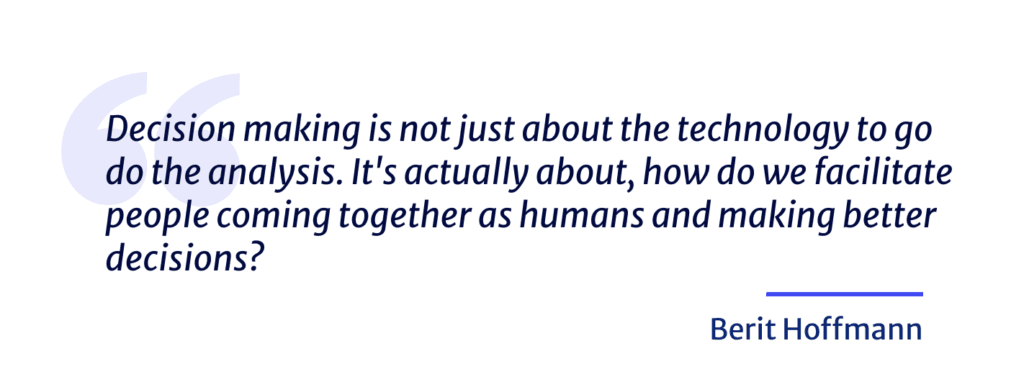
And I share all of that context because I think that helps underline why being able to have Product Management design—and post sales, who’s interacting day-to-day with our customer base—why that really made sense for the type of product that we’re building. To have that very close tie in and very tight feedback loop with people in customer success roles. To have really strong partnership between Product Management and product design, where we’re taking a very human-centered design thinking approach to how we build a product in a space that, candidly, is very crowded.
I like to say, “The world doesn’t need another analytics too.” That’s not what we’re trying to build. We’re trying to really change and facilitate better decision making, which I think requires coming with a deep, deep deep understanding of how businesses are making decisions today. What works about that? What doesn’t?
It’s not just looking at, “Hey, we’re in this little box of analytics tools.” It’s a whole workflow. Being at an earlier stage company a allows you to be a bit more creative or flexible about how you structure an organization, and how you think about Product, and how Product works with other functions in that organization to facilitate the type of customer centricity or user centricity that is going be critical to our success at Sisu.
How did you come up to the decision to have post sales part of the Product team?
It was not that way initially when I started, and it was a decision that we made collaboratively as a leadership team. There was so much knowledge and valuable insight that we knew our post sales team was gathering from how they were interacting and working.
Our target customer is kind of a mid-market to larger enterprise customer. So you’ve got people who are participating in some of that onboarding and implementation and training. We knew that we really wanted to capture the insights and learnings from those interactions and have them feed into and influence how we thought about product strategy and where we invested.
There’s a lot of ways to accomplish that without making org changes, but when we really sat down and looked at it, we felt like, why not? It is nontraditional, it’s a bit of a different approach, but it made sense for what we wanted to achieve, which was that continuous feedback loop.
And also post-sales being very close to what we were building on the product side, because we’re an early stage product. And so if they really understand and know what’s coming in the roadmap, they’re better able to bridge some of that value to customers. We made that change several months back and have really gotten a lot of benefit of that tighter feedback loop.
Related read: Customer Feedback Loops: The Tools You Needs
And you also send a very powerful message to your customers about how much product cares about the entire lifetime of the user, not just about closing the deal and then moving onto the next shiny object.
Exactly. A big shift for me has been actually spending a lot of time on, what is that full customer lifecycle journey? And how do we think about, both from a post sales managing that journey, but also tying that into different product metrics and engagement metrics that we’re looking at at different stages. It’s the full journey. It’s not just closing them up front.
This major trend, Product Led Growth, aligns nicely with what you’re saying. It’s really putting the product at the center of the entire organization and the user journey. Yes, it’s important that product has to represent your company. And there are a lot of users that need to see a little bit of the product before they commit. But it’s also important to invest in product for the users who are part of this journey and make sure they are engaged so they can also extend their agreements with you in a less heavy-lifting way.
Yeah, absolutely. I’m glad you brought up Product Led Growth, because it’s the buzzword of this moment in time. It’s is easy to equate or interpret that Product Led Growth just means free trials, or some kind of purchasing flow that allows someone to have some sort of demo or free trial experience. And I think of it differently.
I think of it as: Product Led Growth is really just a recognition and a decision to say the product experience is a key driver of how we both acquire and expand usage. Because those are the two ways you grow: you acquire new customers, and you get more usage or more value to the customers/users you already have.
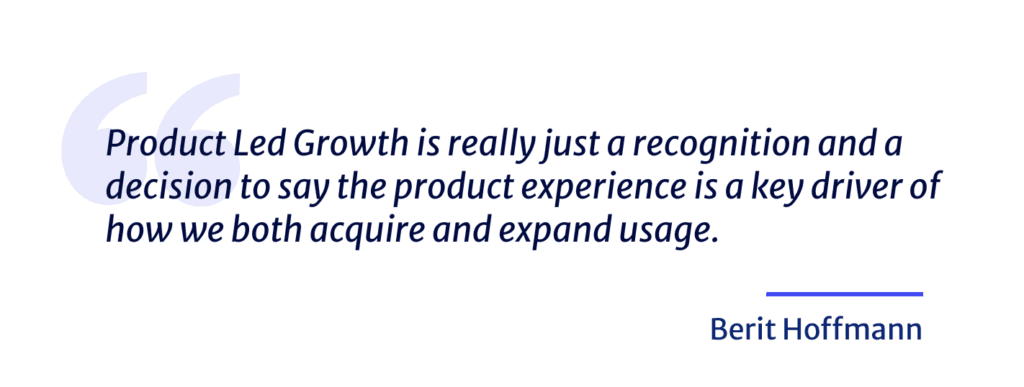
And really all Product Led Growth means is, we are betting on and investing in the product experience as a key lever for that growth. In addition to other more traditional methods, which might be a sales team or different marketing campaigns.
And so to me it’s so much more than a trial experience. Truly the entire product experience, at every moment, depending on where that customer is in their lifecycle and their journey with your product, is how are they experiencing it in a way where they’re seeing increasing value and that is causing them to say, “I want to grow my usage. I want to grow my investment in this product.”
Read up on the topic: Product-Led Growth Strategy for Product Managers
I’m curious to know about your own day to day, because you’re not just alone building. How is your day to day different than your team’s day to day?
I’d bucket my day to day into three categories. And then I’ll try to answer the second part of your question, which is how does that differ than the rest of the team?
The most important thing that we do as Product Leaders or CPOs is going to be defining and aligning the company on our strategy. And that’s where I think we’re recognizing the elevated role that Product plays in the company’s strategy. I think there’s three things that that breaks down into. There’s: what problem are we solving? Who are we solving it for? And how are we solving it?
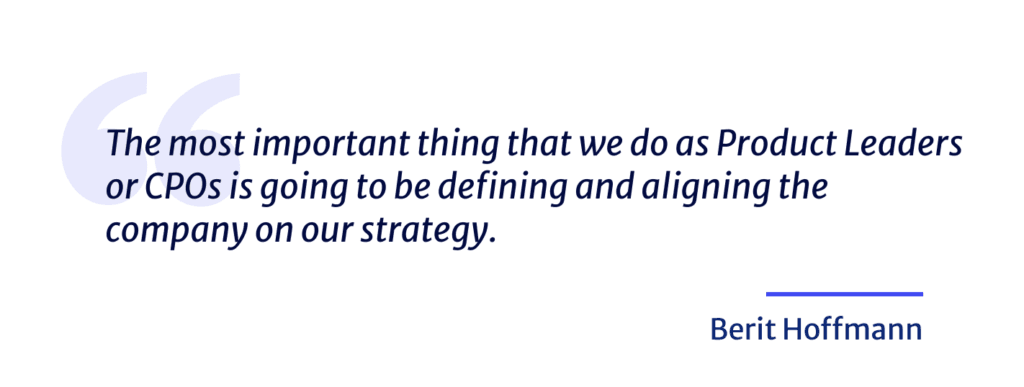
And the what problem are we solving is where I’m spending a ton of time, just really understanding what are these untapped or unaddressed needs that customers have where we have an opportunity. Who are we solving it for, is all about who we’re focusing on, who we’re targeting at that time. And then how is, we better have a differentiated point of view on how we’re gonna do it.
And I wanna underline too, it’s not just about answering them at a point in time. As soon as you think you’ve answered those questions, you probably need to revisit again and say, “Do we still have the right answers? And are we aligned and clear as an organization on our answers to those questions?” It’s not a one time exercise.
And of course there’s a bunch of the executional meetings and things like that. But when I look at my calendar and where my mind share is going, it better be 80 plus percent to: what problem we’re solving, who we’re solving it for, and how we’re solving it.
And I think that the Delta, to get to your question, of how is that different than when you’re an IC or owning a piece of the product, it’s different mostly just at the granularity at which you’re looking at that. Beause that what I just described is what individual Product Leads in a certain area are doing for their area. It really is just a question of time, horizon, and scope at which you’re answering those questions.
I’m trying to think a couple years out, I’m trying to think across the entire company, or the entire product, or if we have multiple product lines. Whereas individual PMs are trying to think more at whatever scope it is that they’re owning.
Watch now: Inspiring With Product Vision by Netflix Director of Product
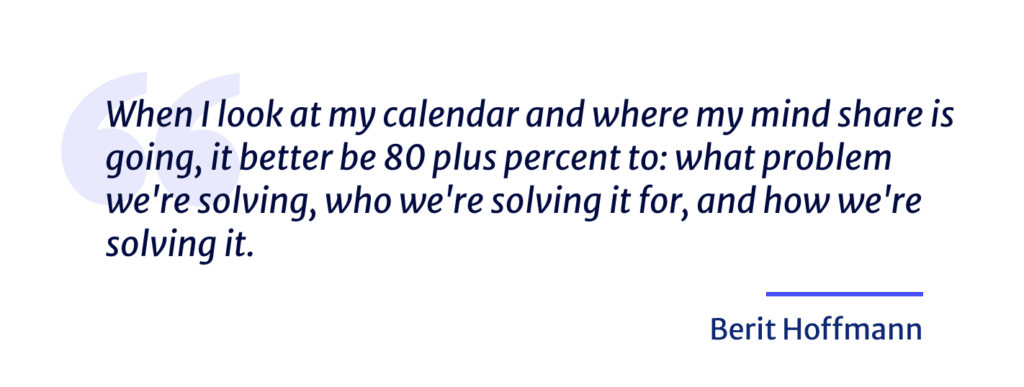
I like that observation big cause there’s a lot of PMs or midlevel PMs in the audience who might be thinking strategies are just for the VPs and CPOs. But it can apply to every single level—maybe your scope is smaller, but everyone should be thinking strategically around the big problems we’re trying to solve.
Absolutely. When you start to recognize that that is actually your charter as a Product Manager, is actually owning, defining, setting, aligning the strategy for whatever scope it is that you own, that is when you shift from being a Product Manager, where you’re just managing tasks, to a Product Leader. Regardless of title. It can be done by individual PMs for the area that they own
Love that, regardless of title. I think leaders lead. And usually people who get promoted have been leaving before that official promotion.
Exactly. Exactly.
How do you go about building a successful product? You mentioned your own background is not technical background. So when you have now the chance to build a team to hire, what are your main ways to do it?
First and foremost, I would say spending time on really saying, “For the stage we’re at, or for the role that I’m hiring, or for the makeup of the team right in now, what am I optimizing for in each hire?”
And I will say one trend or pattern that has been really important to me in the context of startups is finding people who don’t just know how to navigate ambiguity, but they thrive in ambiguity. They are energized by it.
The PMs who do really well in startup or high growth environments are people who, when you throw them a big ambiguous open-ended problem, they’re like, “I love it. Because I get to figure out what this means, where I take it, how I do it.” And look, there are some people who want to be more in a, “Give me a space and let me optimize within this space.” And that’s okay. But those people are not gonna feel energized in a startup environment.
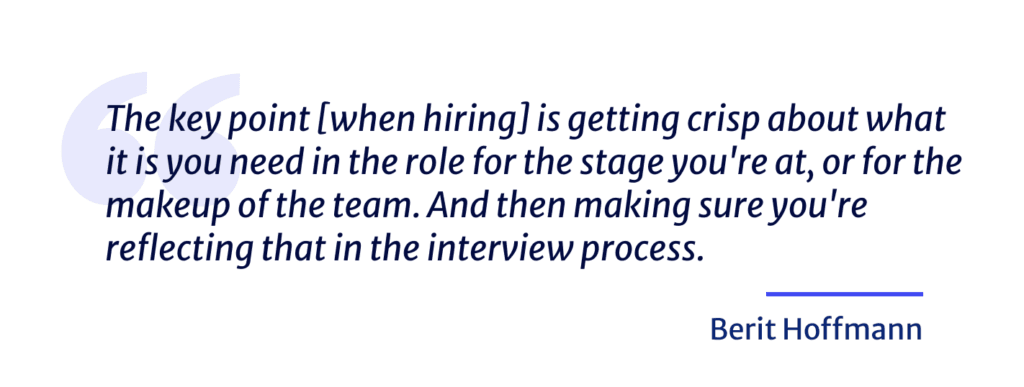
And so one of the things I’m looking for and thinking about when I’m hiring is this needs to be mutual fit on both sides, right? I don’t wanna force someone to do something that they don’t enjoy doing. And, you know, especially at early stage, the company needs pro thinkers, who, who just dig in and love that ambiguity and that complexity and the opportunity to say, I’m gonna set a direction here because there is no defined direction. So that’s one thing. And then I think the, the second thing that I really look for is problem first mentality. You know, I think where I see most projects or, or products go off the rails is when we didn’t spend enough time on really understanding the problem we were solving and why it was important to solve for the, for the segment that, that we chose.
There are ways to test for that. I will intentionally do some really open-ended prompts or discussions in interview processes and say, “Just pitch a product idea.”
Because that starts to test, how do they deal with ambiguity? How do they deal with big open-ended questions like that? Do they really align us on the problem before we start diving into the solution? So again, those are all things I would say, particularly in the context of startup environment, I’m thinking about, “This is what we need, so these are the things I’m gonna test for.”
And I think the key point here is getting crisp about what it is you need in the role for the stage you’re at, or for the makeup of the team. And then making sure you’re reflecting that in the interview process.
Read next: How to Attract, Hire, and Grow Diverse Product Teams
Going back to your positioning as a company for Sisu Data, is that there are a lot of analytics and data tools in this space, which in a way I think confirms that the opportunity is huge. But you said that you don’t want to be yet another solution. So what is that unique position? What is that actual problem that you are solving?
I will go so far as to say, if all we do is build an analytics tool, we will have failed. The world doesn’t need it. So what are we solving? That’s what has been interesting and where we’ve spent a lot of time as a team and company over the last year and a half since I joined, is actually digging into and going and talking to customers.
Not, “tell me how you use X, Y, Z analytics tool.” Because then all you’re doing is you’re just recreating. You’re saying, what’s painful about this space where you’ve boxed in other tools. And instead, talking to analysts, for example, and saying, “Where are you spending your time? What’s painful about it? What are you hoping to accomplish?”
And one of the observations that came out of that is, yeah, they’re creating a bunch of dashboards and traditional BI analytics tools. But what they’re really dealing with is a bunch of ad hoc questions coming up. A bunch of like reactive questions. We see a metric went up, why did it go up? Why did it go down?
And they’re jumping into other tools, whether they’re writing SQL or writing in a Python notebook or trying to cobble it together in a BI tool, and then going and summarizing it in slides and summarizing it in a doc. When you take a step back and say, “Tell me what you’re actually trying to influence. You’re trying to influence and react to decision makers at your company coming with questions about the data. And you’re trying to elevate their understanding and their insights into the data in a way that can influence the decisions they’re trying to make.”
Read next: How to Influence Without Authority
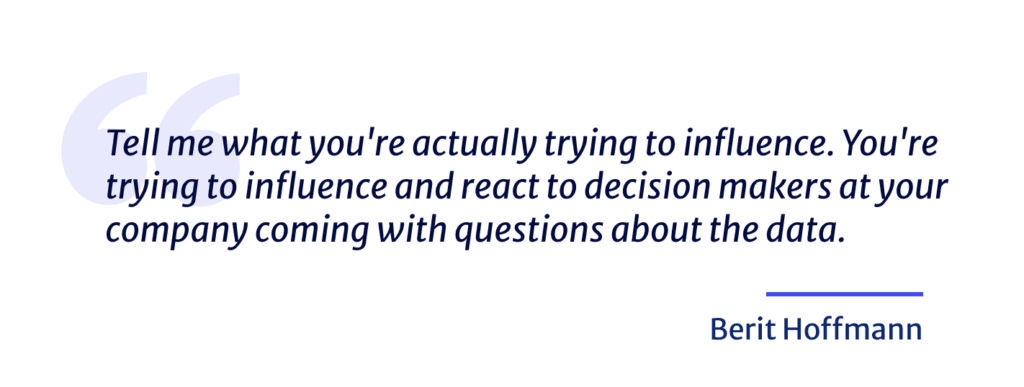
Well, that’s actually spread across a bunch of different tools. And what’s really painful about it is, the way you’re trying to answer some of those diagnostic “why” questions is super manual. They’re going in and they’re saying, “I think maybe it’s this particular subgroup, let me go test.”
What we’re doing with Sisu is we’re saying, flip that on its head and point Sisu at whatever data set you want. Here’s the metric you care about. We will look at every dimension in the data set, every subgroup, the million billions of different combinations of dimensions that constitute subgroups in the data, pull out the ones that actually had statistically significant impact. And that’s where you focus.
So out of these billions of combinations, you’ve got the five that had statistical significance on metric performance. It’s a very concrete example, but to go on that click lower, there’s these “Why” questions, these diagnostic questions that are coming up. You need to answer them in order to influence a decision in a timely way. The tools you’re using to do that today—way too manual. And so that’s the problem we need to solve for you. It’s not, go build another dashboarding tool.
I’ve noticed that in general now it’s data is not just for the data teams. What is the role that the Product Managers are playing now into this entire decision-making process?
There’s kind of two core personas that we think of. We think of that analyzer—and whether they have analyst in their title or not, it’s someone who’s very close to the data. And then the KPI owner. Who could be a Product Manager, could be a leader in customer success, could be a marketing manager.
But it’s that person who, maybe they write SQL, maybe they don’t, but they’re not necessarily in the weeds of the data modeling. But they’re close to the metric they care about. They need to own the performance of that metric.
And so I think a big gap actually in so many analytics tools is, they’ve not been built for collaboration between those two parties. They’ve been built for, “Let’s give you access and visibility into your data.” That’s what a dashboard does. It’s not built for, “How do we collaborate and communicate about this and how do we actually then put together the summary and share it out and make a decision.”
The workflow piece of it, that is where we’re really trying to rethink—actually, a Product Manager is a perfect example of a persona we need to serve—how they collaborate with that analyzer in getting to the right decision.
